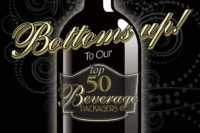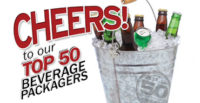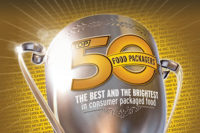Caps off to our Top 50 Beverage Packagers
Making the list is all about brand equity and staying ‘trendy’ including through packaging.

By Rick Lingle, Editor in Chief
As is apparent from our Top 50 Beverage Packagers chart, the beverage market encompasses the whole world, from Belgium (Anheuser-Busch InBev, #1 in our rankings based on 2010 revenues) to Bermuda (Bacardi, #16) and all stops in between and beyond.

To help us go behind the Chart as to what factors can drive consumers toward particular brands as reflected in the results and data, we solicited the input of Denise Lefebvre, VP, Global Beverage Packaging for PepsiCo (#4 on our list), to provide context.
“As consumers move continually toward health and wellness, the requirements on packaging are becoming stricter than ever in terms of active packaging whether for barrier, enhanced product protection or increased functionality of some nature,” offers Lefebvre. “A second ‘lever’ is the importance of design thinking now taken to the next level through packaging: What it can do for the consumer, functionally, pop on-shelf and ‘play’ in the retail space.
“Thirdly, there’s sustainability, which is critical. I would tie that with ‘localization.’ Consumers are really getting into authentic products that are local to them and know where it comes from in the supply chain. That has a ‘halo’ effect on packaging and sustainability: Consumers want products that are natural and authentic, but not overpackaged. Products with an ‘organic’ feel are very important and will continue to be for some time.”
Adding to Lefebvre’s comments are these highlights from two recent studies:
2011 is providing more resilient performance for all beverage packaging materials as economies recover from the downturn. PET bottles hold the greatest volume growth potential of all pack formats, extending their presence in soft drinks, deriving gains from health-aligned consumer intake of juices and ready-to-drink (RTD) tea and through more niche avenues in wine and spirits. Emerging Asia and Latin America markets present the strongest opportunities for packagers, with China and India to head up global growth to 2014, also according to Performance and Prospects for Beverage Packaging Materials, from Euromonitor Intl.
Environmental concerns, hectic consumer lifestyles and increased demand from the Asia Pacific region will all influence the future beverage packaging market, pushing it to achieve $118.8 billion revenues by 2017. That’s according to a new study,Beverage Packaging: A Global Strategic Business Report, from www.companiesandmarkets.com. A trend borne from the recession that appears sustainable is the use of minimal, lightweight packaging materials that incur lower manufacturing and transportation costs, and can be sold at lower prices. This was particularly noted in developed regions, where there has been a distinct focus on cutting household expenditure.
As such, plastic is the beverage packaging material for which there is most demand, on account of its appearance, lightweight qualities, ease of manufacturing and the fact that it is widely recycled.
Busy consumer lifestyles mean that there is demand for food and drink “on the go”, including convenient single-serve beverages. There is still a healthy interest in drinks which promote wellbeing, a feature which is expected to be incorporated into future beverage packaging styles.
New beverages and unusual packaging designs may also see an increased demand for aluminum packaging, potentially in bottle format.
Armed with a shot or two of market intelligence, peruse the world of beverage packaging through the Chart that follows. I’m sure you’ll find some familiar names including personal favorites and you may meet some new faces, too.

The world's best-selling water grows-and grows greener
Nestlé Waters, the third largest U.S. beverage company volumetrically, continues to experience solid growth, with volume sales up 6.5% in 2010. Its Nestlé Pure Life, the biggest-selling water in the U.S. and growing in merging markets, is also the world’s biggest water brand. Although a figurative heavyweight in the bottled waters market, the bottle itself is anything but.
The bottle was made 24% lighter over a five-year period through 2009 when at year’s end the company released the Eco-Shape bottle, the lightest ½-Liter PET bottle at 9.2 grams.
It is also exploring the use of bio-plastics made from renewable resources such as corn, soybean, potato and other plant materials. The company reports that “while ‘first-generation’ bio-plastics are a promising step in creating renewable materials for the future, there are still some technological and economical challenges to overcome, such as their relatively short shelf-life, greater permeability to water and lack of suitable waste collection systems.

7Up cracks the rPET-for-CSD code
Last month, PepsiCo Beverages Canada unveiled the 7UP EcoGreen™ Bottle, North America’s first soft drink bottle made from 100% recycled PET (rPET) that reduces the amount of virgin plastic used by approximately six million pounds yearly.
“After three years of research and development, we have cracked the code to commercially develop a [carbonated] soft drink (CSD) bottle made from 100 percent recycled PET plastic,” says Richard Glover, president, PepsiCo Beverages Canada. “Consumers want products and packaging that reflects their desire to protect the environment, and PepsiCo is committed to delivering on that with this kind of world-class innovation.”
It’s a stepwise development for PepsiCo: The technology is identical to that used for last year’s Naked Juice reNEWa bottle in a non-carbonated application, according to Denise Lefebvre, PepsiCo’s VP, Global Beverage Packaging.
Creating a soft drink bottle made from 100% rPET is more challenging than creating a bottle for non-carbonated beverages because of the stress on materials from carbonation pressure.
“That’s no small technical feat getting to the right quality post-consumer recycle content, particularly for a carbonated soft drink bottle that has so many design requirements from pressure and product retention and utility in the marketplace,” notes Lefebvre. “We see a continued consumer demand for this kind of packaging.”
The bottle will be produced in multiple PepsiCo manufacturing facilities across Canada.
Looking for a reprint of this article?
From high-res PDFs to custom plaques, order your copy today!






